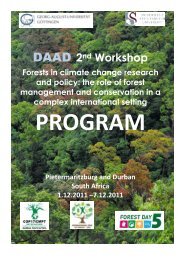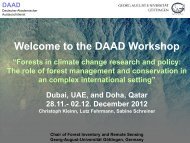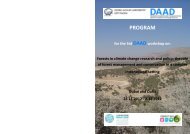Proceedings of the Workshop - Georg-August-Universität Göttingen
Proceedings of the Workshop - Georg-August-Universität Göttingen
Proceedings of the Workshop - Georg-August-Universität Göttingen
You also want an ePaper? Increase the reach of your titles
YUMPU automatically turns print PDFs into web optimized ePapers that Google loves.
period, it has been clear that reduction <strong>of</strong> GHG is a key, if altoge<strong>the</strong>r insufficient, issue,<br />
to promote strategies aimed at minimizing <strong>the</strong> vulnerability <strong>of</strong> fragile areas (FAO 2009).<br />
In <strong>the</strong> case <strong>of</strong> Costa Rica, <strong>the</strong> government has committed to <strong>of</strong>fset <strong>the</strong> emissions<br />
<strong>of</strong> greenhouse gases in <strong>the</strong> country by 2021 (FONAFIFO s.f). In <strong>the</strong> pursuit <strong>of</strong> this<br />
objective, <strong>the</strong> country has been working on a National Climate Change Strategy based<br />
on mitigation and adaptation key actions.<br />
Among <strong>the</strong> main areas proposed in this strategy, which overlap with some <strong>of</strong> <strong>the</strong><br />
actions undertaken by <strong>the</strong> AMISCONDE project, is <strong>the</strong> biodiversity axis: reducing <strong>the</strong><br />
fragmentation <strong>of</strong> ecosystems by creating biological corridors and promoting biodiversity<br />
connectivity, as well as <strong>the</strong> agricultural axis: reducing greenhouse gases by promoting<br />
better agricultural practices(MINAET 2009).<br />
Biological connectivity strategies increase tree cover by natural regeneration or<br />
agr<strong>of</strong>orestry actives, which have a positive effect on greenhouse gas balance, since<br />
degraded areas recover, and essential forest areas are preserved and conserved. De<br />
Melo (2008) also reports that preservation <strong>of</strong> natural forests and agr<strong>of</strong>orestry systems,<br />
especially <strong>the</strong> cultivation <strong>of</strong> c<strong>of</strong>fee, are <strong>the</strong> types <strong>of</strong> land use that provide <strong>the</strong> largest<br />
number <strong>of</strong> Eco-systemic services.<br />
Ano<strong>the</strong>r aspect also taken into consideration by <strong>the</strong> AMISCONDE project was<br />
consolidating protected areas for biodiversity conservation, which, according to INBio<br />
(2009) is a strategy in <strong>the</strong> adaptation process to Global Warming, based on <strong>the</strong><br />
premise that ecosystems protected by conservation areas are less vulnerable and<br />
more able to adapt to climate change than those found outside <strong>the</strong> protected area<br />
networks (Anderson et al. 2008).<br />
According to <strong>the</strong> experience <strong>of</strong> <strong>the</strong> AMISCONDE project, <strong>the</strong> Payments for<br />
Environmental Services program works as an appropriate tool to promote <strong>the</strong> increase<br />
<strong>of</strong> biological connectivity coverage areas, which has a direct impact as a mitigation tool<br />
and also allows integrating agricultural production and conservation. However, PES<br />
needs support from o<strong>the</strong>r strategies, such as environmental education and<br />
dissemination <strong>of</strong> best agricultural practices in production, to reach <strong>the</strong> best results.<br />
It is crucial to keep in mind that <strong>the</strong> experience <strong>of</strong> <strong>the</strong> AMISCONDE project<br />
showed that setting in place <strong>the</strong>se strategies, such as PES, has primarily legal<br />
limitations, such as land tenure, and most <strong>of</strong> <strong>the</strong> time access to <strong>the</strong>se resources are<br />
reserved for small producers, in <strong>the</strong> sense that procedures are complex and lengthy<br />
and require to be partially financed by <strong>the</strong> producer.<br />
5. Conclusions<br />
The strategies proposed by <strong>the</strong> AMISCONDE project, although not designed with <strong>the</strong><br />
specific purpose <strong>of</strong> mitigating and adapting to climate change, showed a synergy with<br />
actions proposed nationally in this field in Costa Rica.<br />
The latter proves that before Global Warming issues played a key role, projects<br />
dealing with <strong>the</strong> issue <strong>of</strong> Nature Conservation used strategies such as creating<br />
biological corridors, promoting best agricultural practices and paying for environmental<br />
services, among o<strong>the</strong>rs, nowadays used as mitigation and adaptation strategies to this<br />
phenomenon.<br />
Throughout <strong>the</strong> implementation <strong>of</strong> <strong>the</strong> AMISCONDE project, it was also observed<br />
that national policies, legal support, and <strong>the</strong> active participation <strong>of</strong> society are key<br />
elements to ensure <strong>the</strong> sustainability <strong>of</strong> any strategies to mitigate and adaptate to<br />
climate change over time.<br />
6. References<br />
‐ 40 -










